50+ Sample Grant Budgets
-

Grant Project Budget
download now -

Mini Grant Budget Sheet
download now -

Basic Grant Budget Template
download now -

Community Engagement Grant Budget
download now -

Mini Grant Budget Sheet
download now -

Summer Grant Budget Sheet
download now -

Sample Program Budget Chart
download now -
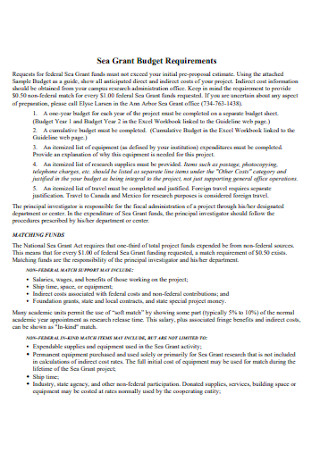
Sea Grant Budget Template
download now -

Simple Grant Budget Template
download now -
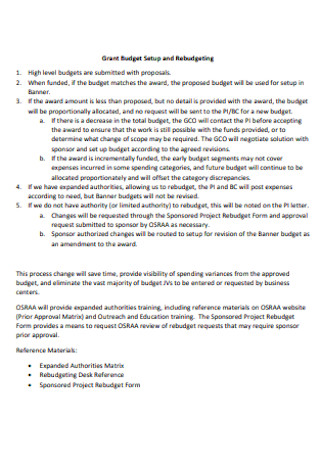
Grant Budget SetupTemplate
download now -
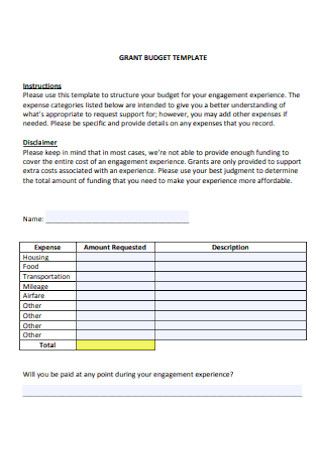
Standard Grant Budget Template
download now -

Street Building Grant Budget
download now -

Broadband Grant Budget
download now -

Fixed Rate Grant Proposal Template
download now -

Project Grant Budget Template
download now -
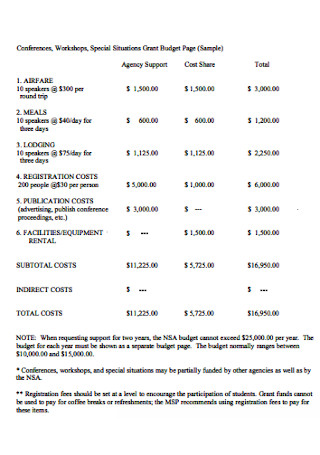
Special Situations Grant Budget
download now -

Small Grant Budget Form
download now -

Networking Grant Budget Form
download now -

Grant Program Budget Form
download now -

Budget for Research Grant Proposal
download now -

Grant Budget Revision Form
download now -

Sample Grant Proposal Budget
download now -

Sample Budget for Grant Proposals
download now -

Grant Budget Receipt
download now -
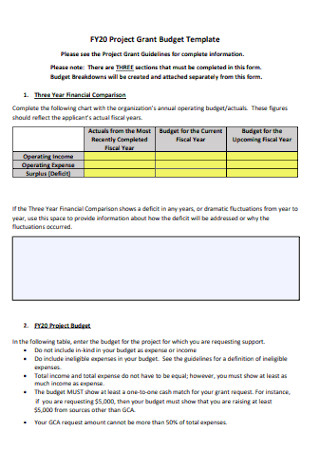
Project Grant Budget Template
download now -

Grant Budget Plan Template
download now -

Empowerment Grant Budget Worksheet
download now -
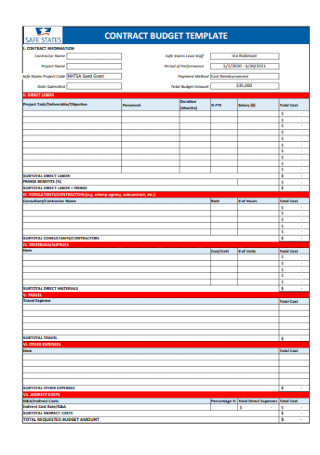
Contract Grant Budget Template
download now -

School Grant Program Budget
download now -

Grant Support Agreement
download now -

Sample Line Item Grant Budget
download now -

Green Team Mini-Grant Budget
download now -

Smart Grant Budget Form
download now -

Sample Grant Planning Budget
download now -
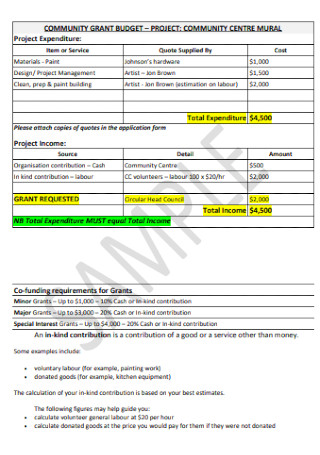
Community Grant Budget Template
download now -

Grant Planning Budget Sheet
download now -

Grant Budgets and Financial Reports
download now -

Descriptions for Grant Budget
download now -

Research Grant Budget
download now -

Organization Budget by Grant
download now -

Clinical Research Grant Budget Example
download now -

Office Grant Budget Template
download now -

Business Fund Grant Budget Template
download now -

Faculty Grant Budget Worksheet
download now -

Adaptive Grant Budget Form
download now -

Grant Budget Revision Policy Template
download now -

Creation Grant Budget
download now -
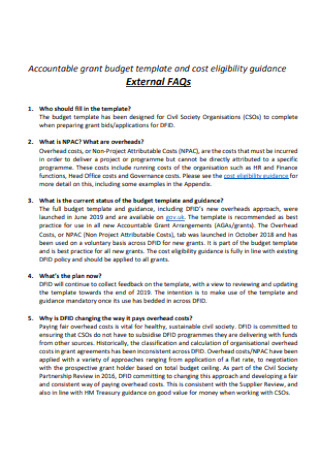
Accountable Grant Budget Template
download now -

Grant Budget Narrative Form
download now -

Stewardship Grant Budget Worksheet
download now
FREE Grant Budget s to Download
50+ Sample Grant Budgets
What is a Grant Budget?
Types of Grants
Effective Grant Management Practices for Nonprofit Organizations
How to Create a Grant Budget
FAQs
What are the types of budgets used in grant funding?
What are the three types of budgets?
What is the purpose of grant proposal writing?
What should be included in a research grant budget?
What are some examples of grant proposals?
How to prepare a grant budget?
What is a Grant Budget?
A grant budget is a type of budget used by grant seekers and grant writers in their grant proposal forms to specify all direct and indirect expenses such as shipping, equipment fees, mailing, supplies, shipping, service costs, transportation, materials, accounting, banking fees, insurance, rent, utilities, and other operations. Some portions of the salaries of project managers, supervisors, consultants, staff, and volunteers are included in a grant budget. It also indicates the time the project will take place and the period the grant is meant to cover, as well as the location of the project.
This document is included in a grant budget proposal to explain the details of the possible expenses for the proposed research project or grant application, reassure funders that the researchers or managers have a logical sense of the expenses to accomplish the proposed work, guarantee the best use of the funds, and facilitates effective and practical implementation of the corporate grant, federal grant, research grant or nonprofit grant programs. Thus, grant budgets matter because they show the necessary funds, they are great investments, and support programs in a sustainable way.
Types of Grants
Approximately 90% of grant applications need at minimum an organizational, program, or project budget. Here are some types of grants used in various fields and industries.
Effective Grant Management Practices for Nonprofit Organizations
Keep things in your nonprofit organization running efficiently and smoothly by implementing necessary disciplines and effective practices for grant management. There are some ways to improve the outcomes of your grant-seeking efforts when you integrate the practices below.
How to Create a Grant Budget
While preparing your grant proposal, you need to be able to create a clear and detailed grant budget to help the grant selection committee to understand the nature and purpose of your project and its budgetary implications. Make sure that your grant budget is clear and well-structured.
Step 1: Use a Budget Spreadsheet Template
Consider using a simple budget spreadsheet for your grant application. Search for a spreadsheet template with outlined columns and heading that outline these items: budget category, requested funds, outside contributions, and grant project total. Go to Sample.net as you choose and download the spreadsheet template you need for your grant.
Step 2: List Down All Your Expenditures
Add the basic components of your grant budget such as direct costs, personnel fees, travel fees, equipment costs, supplies, indirect costs, publication costs, maintenance contract fees, software purchases or licenses, and other expenses for your grant.
Step 3: Calculate the Total Costs
After listing down all your expenditures and other costs for your grant program or funding project, calculate the total costs of all the expenditures. Indicate the total agency cost and the total project cost. The total agency cost is the sum of the direct costs and the indirect costs, while the total project cost is the sum of the total agency cost plus the cost sharing dollar value when cost sharing is utilized.
FAQs
The types of budgets used in grant funding are cost reimbursement and fixed price. A cost reimbursement is when the funding agency will reimburse for the actual costs related to a project. On the other hand, a fixed price is when the funding agency obligates a fixed sum of funds to support the project.
The three types of budgets are a balanced budget, a deficit budget, and a surplus budget. A balanced budget is a type of budget with equal estimated income and projected expenses. A deficit budget is a type of budget with below estimated government spending that contributes to risking the employment rate and drives economic expansion by creating more demand. A surplus budget is a type of budget with higher estimated government revenues that reduces the public debt of the state or boost its savings.
The purpose of grant proposal writing is to secure funding for a research project in all academic disciplines such as the arts, humanities, social sciences, and other fields. In this process, you need to specify the needs and focus, search prospective grants, develop a general proposal and budget, prepare a specific grant proposal, and submit the grant proposal before the deadline.
A research grant budget should include all direct costs, calculated Facilities, and Administrative (F&A) costs. Direct costs are expenses related to a specific sponsored research project like the allocation of supplies and these costs include personnel salaries and benefits, anticipated salary increases, administrative and clerical salaries, employee benefits, Applied Physics Laboratory (APL) costs, personal service contracts, professional consultants, participant support costs, supplies, and materials. F&A costs are expenses that are indirect or not specifically identified with a specific project such as the costs of buildings, services of administrative offices, and utilities.
Some examples of grant proposals are education grant proposals, investigator grant proposals, technology grant proposals, and travel grant proposals.
When you prepare a grant budget, develop internal control systems to highlight financial transparency, figure out your funder’s requirements, estimate realistic costs with your team, explain exactly what the funder will cover, make a detailed comparison to your grant narrative, and examine your grant budget.
What are the types of budgets used in grant funding?
What are the three types of budgets?
What is the purpose of grant proposal writing?
What should be included in a research grant budget?
What are some examples of grant proposals?
How to prepare a grant budget?
A published report by the Foundation Center stated that there are over 86,000 grantmaking entities, with 92% represented by independent foundations. Creating a clear and well-coordinated grant budget is fundamental for grant seekers and funders to have an in-depth picture of how the nonprofit program or research grant project will be organized and managed. Include all the required expenditures and costs for your grant budget. Follow the aforementioned tips in this article on different types of grants, effective grant management practices for nonprofits, and the steps in creating a smart and realistic grant budget. We have sample grant budget templates and other budget templates that you can easily use for your grant budget management such as annual budget templates, operating budget templates, and school budget templates.
